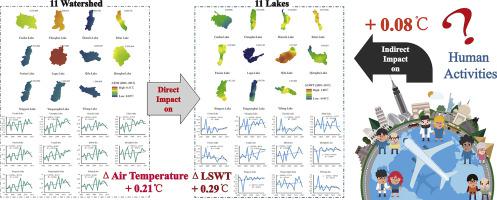Journal of Cleaner Production ( IF 11.1 ) Pub Date : 2020-07-18 , DOI: 10.1016/j.jclepro.2020.122689 Zhenyu Yu , Kun Yang , Yi Luo , Chunxue Shang , Yu Zhu

|
Lake surface water temperature (LSWT) is an important factor for lake ecological environment. Under the influence of natural and human factors, LSWT is generally on the rise. LSWT is affected by lake’s geographical location, climate diversity, biodiversity and cultural diversity of the plateau. To this end, the study used the natural factor (near-surface air temperature) that characterized climate change, the human factors (impermeable surface area, gross domestic product, and population) that characterized human activities, and the physical factors that characterized the lake inherent properties (lake area, watershed area, and water storage) as the dataset, and a hybrid prediction model (ε-SVR-AHP-BPANN) was proposed by combining three algorithms which were ε-support vector regression (ε-SVR), analytic hierarchy process (AHP), and back propagation artificial neural network (BPANN). This model was used to estimate and simulate the LSWT of 11 lakes in the study area from January 2018 to December 2019. Then conducted on the variation characteristics of LSWT for 11 lakes from 2001 to 2019. The results showed that: (1) The hybrid prediction model had a strong predictive power with low error and high generalization (RMSELSWT-day = 0.11, RMSELSWT-night = 0.10, RLSWT-day2 = 0.77, RLSWT-night2 = 0.90). (2) The temporal change analysis showed that, overall, the change rate of LSWT-day showed a warm-cold-warm trend from north to south in Yunnan-Guizhou Plateau, while LSWT-night showed a warm-cold trend. (3) The spatial visualization analysis revealed that there was a general warming trend of LSWT, and the LSWT of northern Erhai Lake were higher than that in southern Erhai Lake, and the distribution of LSWT was regional with the change of latitude.
中文翻译:

湖泊地表水温度预测与变化特征分析-以云贵高原11个天然湖泊为例
湖泊地表水温度(LSWT)是影响湖泊生态环境的重要因素。在自然和人为因素的影响下,LSWT通常呈上升趋势。LSWT受湖泊地理位置,气候多样性,高原生物多样性和文化多样性的影响。为此,研究使用了表征气候变化的自然因素(近地表气温),表征了人类活动的人为因素(不可渗透的表面积,国内生产总值和人口)以及表征湖泊的物理因素。固有属性(湖泊面积,流域面积和蓄水量)作为数据集,并结合ε-支持向量回归(ε-SVR)这三种算法,提出了混合预测模型(ε-SVR-AHP-BPANN),层次分析法(AHP),反向传播人工神经网络(BPANN)。利用该模型对2018年1月至2019年12月研究区的11个湖泊的LSWT进行了估算和模拟。然后对2001年至2019年的11个湖泊的LSWT进行了变化特征研究。结果表明:(1)杂种预测模型具有强大的预测能力,误差低,泛化能力强(RMSE LSWT日 = 0.11,RMSE LSWT夜 = 0.10,R LSWT日2 = 0.77,R LSWT夜2 = 0.90)。(2)时间变化分析表明,总体而言,云贵高原地区LSWT昼夜的变化率呈现出由北向南的暖-冷-暖趋势,而LSWT-night则表现出从北到南的暖-冷趋势。(3)空间可视化分析表明,LSWT存在总体变暖趋势,北部northern海的LSWT高于南部Er海,且LSWT的分布随纬度的变化而呈区域性。


























 京公网安备 11010802027423号
京公网安备 11010802027423号